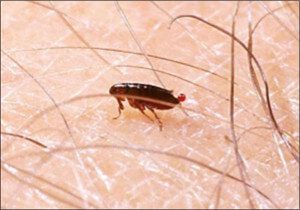
Fleas don’t just itch; they can cause a variety of serious health problems for humans and their pets. Some of those conditions include flea allergy dermatitis, tapeworms and anemia. Flea bites affect everyone differently, but they usually leave red bumps in a concentrated area – often the ankle for humans, and the neck or base of the tail for pets.
Full-grown fleas are very small, only about an eighth of an inch long and are a dark reddish brown color. Although they don’t fly, they can run and jump very well. You can see fleas moving very clearly when you take a close look under the fur of an infested animal. Their mouths and spines lock onto the skin and fur of their hosts, making them difficult to remove.
Controlling fleas is possible with the implementation of a few techniques. Sanitation is very important as it removes the food the fleas need. You should attempt to sterilize the pets themselves as well as their indoor and outdoor living areas. Pesticides are essential, targeting adult fleas as well as their larvae. Cutting the lawn regularly and pulling weeds will make your property less habitable for fleas. Aim to prevent contact between your pets and other animals by not allowing them to roam free into potentially infested areas.

